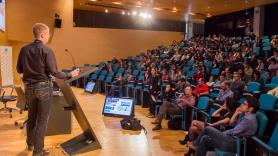Genetic information is stored in DNA, like an instruction manual. But it isn't so easy to read. In general, the same letters appear in books that are as different as a skin cell, liver cell or heart cell. What sets the stories they tell apart then? Epigenetics, the intimate relationship and regulation of the letters and their readers.
Epigenetics is defined as any inheritable biological variation that arises independently from the DNA sequence. Broadly speaking, it encompasses three main blocks: modification of histones (the proteins that coil the genome more tightly or loosely); DNA methylation (a small mark made on one of its letters that conditions how it is read); and non-coding ribonucleic acids (any RNA that isn't involved in protein synthesis and belongs to what is called the dark genome or junk DNA, which makes up 98% of the genetic sequence and until recently was disregarded with mistaken anticipation.
All of these mechanisms allow a single cell to turn into neurons, bones and lymphocytes. And their importance means that errors in the machinery can lead to tumors or even autism. As they are inheritable, if changes occur in the sex cells, some of them could be passed on to an individual’s descendants.
To discuss part of the new advances, some of the top international experts in the field met for a B·Debate session, an initiative of Biocat and the “la Caixa” Foundation to promote scientific debate.
CONCLUSIONS:
- Genes only make up 2% of the genome. The other 98% is what has been called dark or junk DNA. Not recognizing the importance of this 98% was a mistake, as most of it works to regulate how the other 2% behaves.
- Dark DNA is one of the keys of epigenetics, the inheritable changes don’t depend on the DNA sequence, and they regulate gene activity.
- Epigenetics allows different cells and organs to be created from the same DNA. Epigenetic alterations have been associated with a wide range of illnesses, including cancer and autism, and research is being done to find therapies to undo them.
- Epigenetics can be modified by the environment, and it seems that some of these changes can be passed down to future generations.



